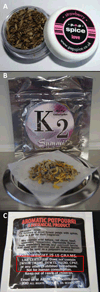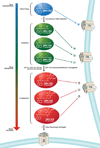Spice drugs are more than harmless herbal blends: a review of the pharmacology and toxicology of synthetic cannabinoids
- PMID: 22561602
- PMCID: PMC3936256
- DOI: 10.1016/j.pnpbp.2012.04.017
Spice drugs are more than harmless herbal blends: a review of the pharmacology and toxicology of synthetic cannabinoids
Abstract
"K2" and "Spice" drugs (collectively hereafter referred to as Spice) represent a relatively new class of designer drugs that have recently emerged as popular alternatives to marijuana, otherwise characterized as "legal highs". These drugs are readily available on the Internet and sold in many head shops and convenience stores under the disguise of innocuous products like herbal blends, incense, or air fresheners. Although package labels indicate "not for human consumption", the number of intoxicated people presenting to emergency departments is dramatically increasing. The lack of validated and standardized human testing procedures and an endless supply of potential drugs of abuse are primary reasons why researchers find it difficult to fully characterize clinical consequences associated with Spice. While the exact chemical composition and toxicology of Spice remains to be determined, there is mounting evidence identifying several synthetic cannabinoids as causative agents responsible for psychoactive and adverse physical effects. This review provides updates of the legal status of common synthetic cannabinoids detected in Spice and analytical procedures used to test Spice products and human specimens collected under a variety of clinical circumstances. The pharmacological and toxicological consequences of synthetic cannabinoid abuse are also reviewed to provide a future perspective on potential short- and long-term implications.
Copyright © 2012 Elsevier Inc. All rights reserved.
Figures


References
-
- Ameri A. The effects of cannabinoids on the brain. Prog. Neurobiol. 1999;58:315–348. - PubMed
-
- American Association of Poison Control Centre (AAPCC) [accessed May 13, 2011];Fake marijuana spurs more than 4,500 calls to US Poison Centers. 2011 Available at: http://www.aapcc.org/dnn/Portals/0/prrel/updatedk2-may112011.pdf.
-
- Ashton CH, Moore PB. Endocannabinoid system dysfunction in mood and related disorders. Acta Psychiatr. Scand. 2011;124:250–261. - PubMed
Publication types
MeSH terms
Substances
Grants and funding
LinkOut - more resources
Full Text Sources

